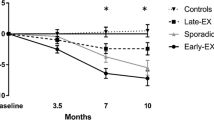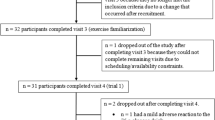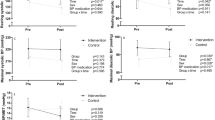Abstract
Objective:
To measure adherence to a specific exercise prescription (1500 kcal week−1) by objectively quantifying unsupervised exercise energy expenditure (ExEE) in obese women.
Design:
The 16-week lifestyle intervention consisted of weekly meetings with research staff and promotion of increased ExEE (1500 kcal week−1) and a decreased dietary intake (−500 kcal day−1).
Participants:
Twenty-nine obese females (body mass index=36.8±5.0 kg m−2, body fat=49.6±3.7%) from a hospital-based lifestyle intervention were included in the analysis.
Measurements:
ExEE was estimated and monitored weekly using heart rate monitoring, and body composition was measured before and after the intervention by dual-energy X-ray absorptiometry.
Results:
Free-living adherence to the exercise prescription was variable and, on average, modest such that 14% achieved 1500 kcal week−1, and the average weekly ExEE (768 kcal week−1) represented 51.2% of the total amount prescribed. ExEE was correlated with changes in body weight (r=0.65, P<0.001) and fat mass (r=0.65, P<0.001). Achievement of a 5% weight loss target was dependent on the achievement of an ExEE level of 1000 kcal week−1 (P<0.001). Exercise ‘adherers’ (>1000 kcal week−1) lost more weight (−9.9 vs −4.1 kg), more fat mass (−6.8 vs −3.0 kg) and more waist circumference (−9.8 vs −5.6 cm) when compared to ‘non-adherers’ (<1000 kcal week−1).
Discussion:
Exercise is an integral component of lifestyle interventions aimed at reducing obesity and its complications. However, without accurate and objective measures of ExEE, it is difficult for relationships between exercise and health outcomes to be elucidated. The present study suggests an alternative to self-report to increase the confidence with which conclusions are drawn regarding the role of exercise within lifestyle interventions.
This is a preview of subscription content, access via your institution
Access options
Subscribe to this journal
Receive 12 print issues and online access
$259.00 per year
only $21.58 per issue
Buy this article
- Purchase on Springer Link
- Instant access to full article PDF
Prices may be subject to local taxes which are calculated during checkout




Similar content being viewed by others
References
Saris WH, Blair SN, van Baak MA, Eaton SB, Davies PS, Di Pietro L et al. How much physical activity is enough to prevent unhealthy weight gain? Outcome of the IASO 1st Stock Conference and consensus statement. Obes Rev 2003; 4: 101–114.
U.S. Department of Health and Human Services. Physical Activity and Health: A Report of the Surgeon General, in National Center for Chronic Disease Prevention and Health Promotion. U.S. Department of Health and Human Services, Centers for Disease Control and Prevention: Atlanta, GA, 1996.
Pollock M, Gaesser G, Butcher J, Després JP, Dishman R, Franklin B et al. American college of sports medicine position stand: the recommended quantity and quality of exercise for developing and maintaining cardiorespiratory and muscular fitness, and flexibility in healthy adults. Med Sci Sports Exerc 1998; 30: 975–991.
Hills A, Byrne N, Wearing S, Armstrong T . Validation of the intensity of walking for pleasure in obese adults. Prev Med 2006; 42: 47–50.
Ross R, Dagnone D, Jones PJ, Smith H, Paddags A, Hudson R et al. Reduction in obesity and related comorbid conditions after diet-induced weight loss or exercise-induced weight loss in men. Ann Int Med 2000; 133: 92–103.
Ross R, Freeman J, Hudson R, Janssen I . Abdominal obesity, muscle composition, and insulin resistance in premenopausal women. J Clin Endocrinol Metab 2002; 87: 5044–5051.
Ross R, Janssen I, Dawson J, Kungl AM, Kuk JL, Wong SL et al. Exercise-induced reduction in obesity and insulin resistance in women: a randomized controlled trial. Obes Res 2004; 12: 789–798.
Slentz CA, Duscha BD, Johnson JL, Ketchum K, Aiken LB, Samsa GP et al. Effects of amount of exercise on body weight body composition and measures of central obesity: STRRIDE—a randomized controlled study. Arch Intern Med 2004; 164: 31–39.
Jeffery RW, Wing RR, Sherwood N, Tate D . Physical activity and weight loss: does prescribing higher physical activity goals improve outcome? Am J Clin Nutr 2003; 78: 684–689.
Eriksson KF, Lindgarde F . Prevention of type 2 (non-insulin dependent) diabetes mellitus by diet and physical exercise. Diabetologia 1991; 34: 891–898.
Li G, Hu Y, Yang W, Jiang Y, Wang J, Xiao J et al. Effects of insulin resistance and insulin secretion on the efficacy of interventions to retard development of type 2 diabetes mellitus: the DA Qing IGT and Diabetes Study. Diabetes Res Clin Pract 2002; 58: 193–200.
Lindstrom J, Louheranta A, Mannelin M, Rastas M, Salminen V, Eriksson J, et al., Finnish Diabetes Prevention Study Group. The Finnish diabetes prevention study (DPS). Diabetes Care 2003; 26: 3230–3236.
The Diabetes Prevention Program Research Group. Reduction in the incidence of type II diabetes with lifestyle intervention or Metformin. N Engl J Med 2002; 346: 393–403.
Kriska A . Can a physically active lifestyle prevent type 2 diabetes? Ex Sport Sci Rev 2003; 31: 132–137.
Sato Y, Nagasaki M, Kubota M, Uno T, Nakai N . Clinical aspects of physical exercise for diabetes/metabolic syndrome. Diabetes Res Clin Pract 2007; 77: S87–S91.
Jacobsen D, Donnelly JE, Snyder-Heelan K, Livingston K . Adherence and attrition with intermittent and continuous exercise in overweight women. Int J Sports Med 2003; 24: 459–464.
Lafortuna C, Resnik M, Galvani C, Sartorio A . Effects of non-specific vs individualized exercise training protocols on aerobic, anaerobic and strength performance in severely obese subjects during a short-term body mass reduction program. J Endocrinol Invest 2003; 26: 197–205.
Conway J, Seale J, Jacobs D, Irwin M, Ainsworth B . Comparison of energy expenditure estimates from doubly labeled water, a physical activity questionnaire, and physical activity records. Am J Clin Nutr 2002; 75: 519–525.
Walsh M, Hunter GR, Sirikul B, Gower B . Comparison of self-reported with objectively assessed energy expenditure in black and white women before and after weight loss. Am J Clin Nutr 2004; 79: 1013–1019.
Schoeller DA . But how much physical activity? Am J Clin Nutr 2003; 78: 669–670.
Donnelly JE, Kirk E, Jacobsen D, Hill JO, Sullivan DK, Johnson SL . Effects of 16 mo of verified, supervised aerobic exercise on macronutrient intake in overweight men and women: the midwest exercise trial. Am J Clin Nutr 2003; 78: 950–956.
Leon AS, Casal D, Jacobs DRJ . Effects of 2,000 kcal per week of walking and stair climbing on physical fitness and risk factors for coronary heart disease. J Cardiopulm Rehabil 1996; 16: 183–192.
Hiilloskorpi H, Fogelholm M, Laukkanen R, Pasanen M, Oja P, Mänttäri A et al. Factors affecting the relation between heart rate and energy expenditure during exercise. Int J Sports Med 1999; 20: 438–443.
Hiilloskorpi H, Pasanen M, Fogelholm M, Laukkanen R, Manttari A . Use of heart rate to predict energy expenditure from low to high activity levels. Int J Sports Med 2003; 24: 332–336.
Schutz Y, Weinsier RL, Hunter GR . Assessment of free-living physical activity in humans: an overview of currently available and proposed new measures. Obes Res 2001; 9: 368–379.
Bland J, Altman D . Statistical methods for assessing agreement between two methods of clinical measurement. Lancet 1986; 1: 307–310.
Byrne N, Meerkin J, Laukkanen R, Ross R, Fogelholm M, Hills AP . Weight loss strategies for obese adults: personalized weight management program vs standard care. Obes Res 2006; 14: 1777–1788.
The Diabetes Prevention Program Research Group. Achieving weight and activity goals among diabetes prevention program lifestyle participants. Obes Res 2004; 12: 1426–1434.
Jakicic JM, Wing RR, Winters-Hart C . Relationship of physical activity to eating behaviours and weight loss in women. Med Sci Sports Exerc 2002; 34: 1653–1659.
Dunn C, Hannan P, Jeffery RW, Sherwood NE, Pronk NP, Boyle R . The comparative and cumulative effects of a dietary restriction and exercise on weight loss. Int J Obes 2006; 30: 112–121.
Hill J, Wyatt H . Role of physical activity in preventing and treating obesity. J Appl Physiol 2005; 99: 765–770.
Delahanty L, Conroy M, Nathan D . Psychological predictors of physical activity in the diabetes prevention program. J Am Diet Assoc 2006; 106: 698–705.
Browning R, Kram R . Energetic cost and preferred speed of walking in obese vs normal weight women. Obes Res 2005; 13: 891–899.
Ekkekakis P, Lind E . Exercise does not feel the same when you are overweight: the impact of self-selected and imposed intensity on affect and exertion. Int J Obes Relat Metab Disord 2006; 3: 652–660.
Hulens M, Vansant G, Claessens AL, Lysens R, Muls E . Predictors of 6-minute walk test results in lean, obese and morbidly obese women. Scand J Med Sci in Sports 2003; 13: 98–105.
Mattsson E, Larsson U, Rossner S . Is walking for exercise too exhausting for obese women? Int J Obes Relat Metab Disord 1997; 21: 380–386.
Bauman A, Sallis J, Dzewaltowski D, Owen N . Toward a better understanding of the influences on physical activity the role of determinants, correlates, causal variables, mediators, moderators, and confounders. Am J Prev Med 2002; 23: 5–14.
Acknowledgements
We thank Anais D’Arcy, Kathryn Nolan and Dr Clair Sullivan for their extensive contributions to this research project and also the participants for their time, commitment and dedication throughout the trial.
Author information
Authors and Affiliations
Corresponding author
Rights and permissions
About this article
Cite this article
Colley, R., Hills, A., O'Moore-Sullivan, T. et al. Variability in adherence to an unsupervised exercise prescription in obese women. Int J Obes 32, 837–844 (2008). https://doi.org/10.1038/sj.ijo.0803799
Received:
Revised:
Accepted:
Published:
Issue Date:
DOI: https://doi.org/10.1038/sj.ijo.0803799
Keywords
This article is cited by
-
Compensatory Responses to Exercise Training As Barriers to Weight Loss: Changes in Energy Intake and Non-exercise Physical Activity
Current Nutrition Reports (2023)
-
Patient predictors of weight loss following a behavioral weight management intervention among US Veterans with severe obesity
Eating and Weight Disorders - Studies on Anorexia, Bulimia and Obesity (2018)
-
A Systematic Review of Physical Activity Interventions in Individuals with Binge Eating Disorders
Current Obesity Reports (2018)
-
Multidimensional improvements induced by an intensive obesity inpatients rehabilitation programme
Eating and Weight Disorders - Studies on Anorexia, Bulimia and Obesity (2017)
-
Associations between physical activity and quality of life outcomes in adults with severe obesity: a cross-sectional study prior to the beginning of a lifestyle intervention
Health and Quality of Life Outcomes (2013)



